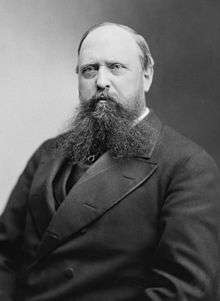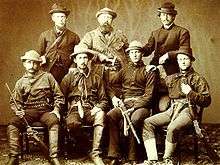Othniel Charles Marsh
| Othniel Charles Marsh | |
|---|---|
 | |
| Born |
October 29, 1831 Lockport, New York, USA |
| Died |
March 18, 1899 (aged 67) New Haven, Connecticut, USA |
| Nationality | American |
| Institutions | Yale University |
| Alma mater | Yale College |
| Notable awards | Bigsby Medal (1877) |
|
Signature | |
Othniel Charles Marsh (October 29, 1831 – March 18, 1899) was an American paleontologist. Marsh was one of the preeminent scientists in the field; the discovery or description of dozens of new species and theories on the origins of birds are among his legacies.
Born into a modest family, Marsh was able to afford higher education thanks to the generosity of his wealthy uncle George Peabody. After graduating from Yale College in 1860 he traveled the world, studying anatomy, mineralogy and geology. He obtained a teaching position at Yale upon his return. From the 1870s to 1890s he competed with rival paleontologist Edward Drinker Cope in a period of frenzied Western American expeditions known as the Bone Wars.
Biography
A comprehensive personal and scientific biography of Professor Marsh, written for the National Academy of Sciences by the American paleontologist Charles Schuchert is available on the NAS website.[1]
Early life
Marsh was born October 29, 1831 in Lockport, New York, United States, to a family of modest means. His mother, the younger sister of wealthy banker and philanthropist George Peabody, died when Marsh was less than three years old; however, the financial backing of his uncle allowed Marsh to obtain a formal education.[2] He graduated from Phillips Academy, Andover in 1856 and Yale College in 1860.[3] He then studied geology and mineralogy at Yale's Sheffield Scientific School (1860-1862), and afterwards paleontology and anatomy in Berlin, Heidelberg and Breslau (1862-1865).[4] He returned to the United States in 1866 and was appointed professor of vertebrate paleontology at Yale University. The same year, the Peabody Museum of Natural History at Yale was founded with a donation from George Peabody, on Marsh's suggestion.[2]

Career
Marsh and his many fossil hunters were able to uncover about 500 new species of fossil animals, which were all named later by Marsh himself. In May 1871, Marsh uncovered the first pterosaur fossils found in America. He also found early horses, flying reptiles, Cretaceous and Jurassic dinosaurs such as Triceratops, Stegosaurus, Apatosaurus and Allosaurus, and described the toothed birds of the Cretaceous Ichthyornis and Hesperornis.
Marsh served as Vertebrate Paleontologist of the U.S. Geological Survey from 1882 to 1892.[2] Thanks to John Wesley Powell, head of the USGS, and Marsh's contacts in Washington, Marsh was placed at the head of the consolidated government survey in the late 1880s.[5]
Between 1883 and 1895, Marsh was President of the National Academy of Sciences.[2]
On December 13, 1897, Marsh received the Cuvier Prize of 1,500 francs from the French Academy of Science.[6]
Death
Marsh died on March 18, 1899, a few years after his great rival Cope.[3] He was interred at the Grove Street Cemetery in New Haven, Connecticut.
Bone Wars
Marsh is also known for the so-called "Bone Wars" waged against Edward Drinker Cope. The two men were fiercely competitive, discovering and documenting more than 120 new species of dinosaur between them.
In the winter of 1863, Marsh first met Cope while in Berlin. Marsh, age thirty-two, was attending the University of Berlin. He held two university degrees in comparison to Cope's lack of formal schooling past sixteen, but Cope had written 37 scientific papers in comparison to Marsh's two published works. While they would later become rivals, on meeting the two men appeared to take a liking to each other. Marsh led Cope on a tour of the city, and they stayed together for days. After Cope left Berlin the two maintained correspondence, exchanging manuscripts, fossils, and photographs.
The two began to develop a rivalry when Marsh allegedly pointed out that Cope had placed the skull of Elasmosaurus at the end of its tail. Cope attempted to buy back the papers containing his flawed reconstruction, but Joseph Leidy exposed his cover-up at a meeting of the Academy of Natural Sciences. This rivalry went on throughout their lives.
Marsh eventually "won" the Bone Wars by finding 80 new species of dinosaur, while Cope found 56. Cope did not take this lightly, and the two debated each other in scientific journals for many years to come.
Legacy
Marsh named the following dinosaur genera:
- Allosaurus (1877)
- Ammosaurus (1890)
- Anchisaurus (1885)
- Apatornis (1873)
- Apatosaurus (1877)
- Atlantosaurus (1877)
- Barosaurus (1890)
- Brontosaurus (1879)
- Camptosaurus (1885)
- Ceratops (1888)
- Ceratosaurus (1884)
- Claosaurus (1890)
- Coelurus (1879)
- Coniornis (1893)
- Creosaurus (1878)
- Diplodocus (1878)
- Diracodon (1881)
- Dryosaurus (1894)
- Dryptosaurus (1877)
- Hesperornis (1872)
- Ichthyornis (1873)
- Labrosaurus (1896)
- Laosaurus (1878)
- Lestornis (1876)
- Nanosaurus (1877)
- Nodosaurus (1889)
- Ornithomimus (1890)
- Pleurocoelus (1891)
- Priconodon (1888)
- Stegosaurus (1877)
- Torosaurus (1891)
- Triceratops (1889)

He named the suborders Ceratopsia (1890), Ceratosauria (1884), Ornithopoda (1881), Stegosauria (1877), and Theropoda.
He also named the families Allosauridae (1878), Anchisauridae (1885), Camptosauridae (1885), Ceratopsidae (1890), Ceratosauridae, Coeluridae, Diplodocidae (1884), Dryptosauridae (1890), Nodosauridae (1890), Ornithomimidae (1890), Plateosauridae (1895), and Stegosauridae (1880).
He also named many individual species of dinosaurs.
Dinosaurs named by others in honour of Marsh include Hoplitosaurus marshi (Lucas, 1901), Iaceornis marshi (Clarke, 2004), Marshosaurus (Madsen, 1976), Othnielia (Galton, 1977), and Othnielosaurus (Galton, 2007).
Marsh's finds formed the original core of the collection of Yale's Peabody Museum of Natural History. The museum's Great Hall is dominated by the first fossil skeleton of Brontosaurus that he discovered, which was reclassified as Apatosaurus for a time. However, an extensive study published in 2015 concluded that Brontosaurus was a valid genus of sauropod distinct from Apatosaurus.[7][8][9]
He donated his home in New Haven, Connecticut, to Yale University in 1899. The Othniel C. Marsh House, now known as Marsh Hall, is designated a National Historic Landmark. The grounds are now known as the Marsh Botanical Garden.
Marsh was elected a member of the American Antiquarian Society in 1877.[10]
See also
References
- ↑ "Biographical Memoir of Othniel Charles Marsh (1831-1899)" (PDF). National Academy of Sciences. Retrieved 2015-04-09.
- 1 2 3 4 "Othniel Charles Marsh". Yale Peabody Museum of Natural History. 2017. Retrieved 2017-07-27.
- 1 2 "Professor Marsh is Dead. The World-Famous Geologist Succumbs to Pneumonia. Chair of Paleontology Founded for Him. Caused the Establishment of Peabody Museum". New York Times. March 19, 1899. Retrieved 2010-07-28.
Othniel C. Marsh, M.A., Ph.D., LL.D., professor of paleontology at Yale University, curator of the geological collection at the same institution, ...
- ↑
 Rines, George Edwin, ed. (1920). "Marsh, Othniel Charles". Encyclopedia Americana.
Rines, George Edwin, ed. (1920). "Marsh, Othniel Charles". Encyclopedia Americana. - ↑ Wallace, David Rains (1999). The Bonehunters' Revenge: Dinosaurs, Greed, and the Greatest Scientific Feud of the Gilded Age. Houghton Mifflin Books. pp. 175–179. ISBN 0-618-08240-9.
- ↑ "Minor Paragraphs". Popular science monthly: 574. Feb 1898. Retrieved 13 May 2013.
- ↑ Tschopp, E.; Mateus, O. V.; Benson, R. B. J. (2015). "A specimen-level phylogenetic analysis and taxonomic revision of Diplodocidae (Dinosauria, Sauropoda)". PeerJ. 3: e857. PMC 4393826
 . PMID 25870766. doi:10.7717/peerj.857.
. PMID 25870766. doi:10.7717/peerj.857.
- ↑ Gorman, James (7 April 2015). "A Prehistoric Giant Is Revived, if Only in Name". New York Times. Retrieved 7 April 2015.
- ↑ ScientificAmerican.com The Brontosaurus is Back 2015-4-17
- ↑ American Antiquarian Society Members Directory
Further reading
- University of California Museum of Paleontology. "Othniel Charles Marsh (1832–1899)". UC Berkeley. Retrieved 2007-03-07.
- "Othniel Charles Marsh (1831–1899)". Lefalophodon. National Center for Ecological Analysis and Synthesis. Retrieved 2007-03-07.
- The Scientific Contributions of Othniel Charles Marsh: Birds, Bones, and Brontotheres (Peabody Museum of Natural History Special Publication No 15) (Paperback) by Mark J. McCarren
- Jaffe, Mark (2000). The Gilded Dinosaur: The Fossil War Between E. D. Cope and O. C. Marsh and the Rise of American Science. New York: Crown Publishing Group. ISBN 0-517-70760-8.
- Lanham, Url (1973). The Bone Hunters. New York and London: Columbia University Press. ISBN 0-231-03152-1.
- Wilford, John Noble (1985). The Riddle of the Dinosaur. New York: Knopf Publishing. ISBN 0-394-74392-X.
External links
| Wikisource has original works written by or about: Othniel Charles Marsh |
| Wikimedia Commons has media related to Othniel Charles Marsh. |
- Works by or about Othniel Charles Marsh at Internet Archive
- "Dinosaur Wars". American Experience. 01/17/2011. PBS. Check date values in:
|date=(help) - O. C. Marsh Papers. marsh.dinodb.com
- View works by Othniel Charles Marsh online at the Biodiversity Heritage Library.
- National Academy of Sciences Biographical Memoir